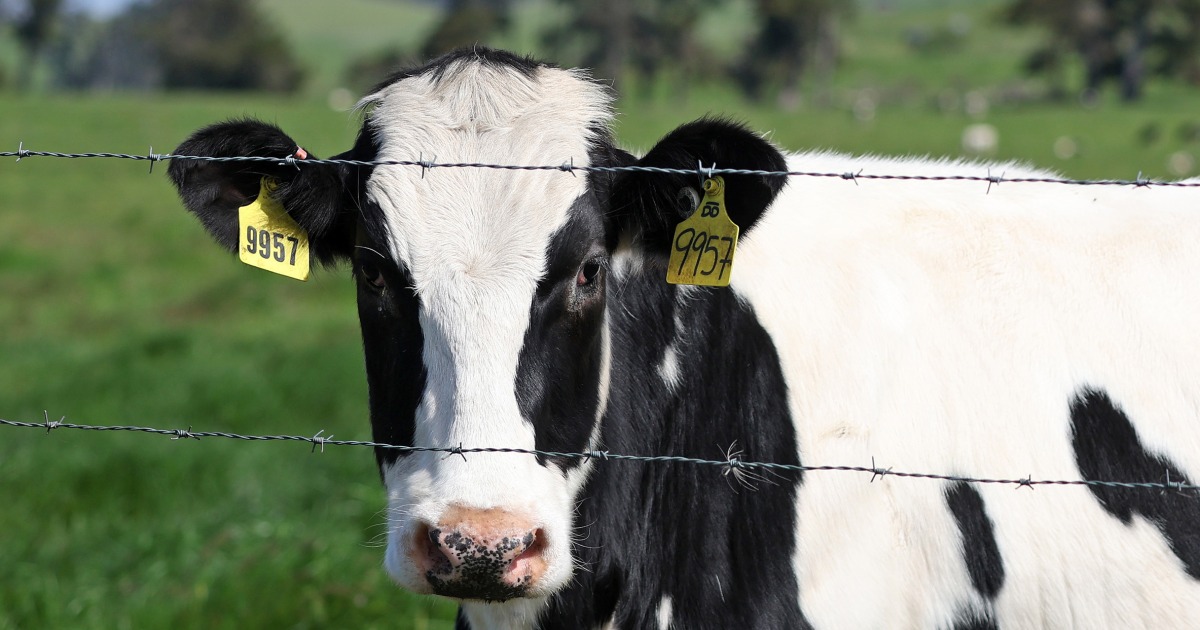
A second person in the U.S. has been infected with bird flu linkedto dairy cows, the Michigan Department of Health and Human Services reported Wednesday.
The person, a farmworker who had regular exposure to infected livestock, had mild symptoms and has recovered, the health department said.
“The current health risk to the general public remains low,” Dr. Natasha Bagdasarian, Michigan’s chief medical executive, said in a news release. “We have not seen signs of sustained human-to-human transmission at this point. This is exactly how public health is meant to work, in early detection and monitoring of new and emerging illnesses.”
The person was being monitored for symptoms following exposure to infected dairy cows, the Centers for Disease Control and Prevention said in a statement. The person developed conjunctivitis, or pinkeye, and a sample taken from the eye tested positive for the virus. A sample taken from the person’s nasal passages was negative.
At a news briefing Wednesday, Dr. Nirav Shah, the CDC’s principal deputy director, said the negative nasal sample is reassuring, in a sense.
“It reduces the likelihood — it does not eliminate, but it reduces the likelihood — of a respiratory route of transmission,” Shah said.
It is the second instance of a person’s developing pinkeye from a bird flu infection. That was also the only symptom in the Texas dairy worker who was diagnosed in March in the first documented case of the virus’ spreading from dairy cows to a human.
More information about how the virus spread will be gleaned from its genetic sequence, including whether it has acquired any mutations that could allow it to spread between people more easily. The CDC is working to sequence samples of the virus taken from the Michigan worker and is expected carry out the genetic analysis later this week, Shah said.
“I don’t think this changes the risk picture in terms of the virus being transmitted to people and then transmitted among people,” said infectious disease expert Michael Osterholm, director of the Center for Infectious Disease Research and Policy at the University of Minnesota.
Dawn O’Connell, the assistant secretary for preparedness and response at the Department of Health and Human Services, said at the news briefing that last week, the government had started the “fill and finish” process for about 4.8 million doses of a vaccine that is well-matched to the bird flu, the final step needed before vaccines are ready to distribute.
The process takes a couple of months, O’Connell said, adding that while the current risk to general public remains low, the move is an effort to save time in the future should the virus become more widespread.
Shah asked state and local health authorities in a call Tuesday to continue monitoring for flu “at enhanced levels” throughout the summer, even though the typical flu season is over and testing for the virus falls to a minimum at this time of year.
On Wednesday’s call, Shah noted that no increases in influenza-like illnesses have been detected in the region surrounding the Michigan worker’s farm.
Since this strain of the bird flu virus, called H5N1, was first identified in 1997, just over 900 cases have been documented in humans worldwide. More than 50% of those patients died, according to the CDC. But that death rate may be an overestimate, because other cases may be mild and could go undetected.
It is the third case of H5N1 overall in the U.S. In 2022, an inmate in Colorado was diagnosed with the virus. The man was working on a commercial farm culling birds suspected to be infected. His only symptom was fatigue, and he recovered with a course of Tamiflu.
There is no evidence that H5N1 is spreading from person to person. None of the people living with the Texas dairy worker became ill.
At the news briefing Wednesday, Shah said that while the risk to general public remains low, the risk to farmworkers is elevated.
The CDC recommends that anyone in contact with dairy cattle wear protective equipment, including safety glasses, waterproof aprons and boots that can be sanitized.
Osterholm said he suspects there will be more cases.
“I wouldn’t be surprised if we saw five, six, 10 cases in the next few weeks,” he said.
The Michigan Department of Agriculture and Rural Development confirmed additional cases in cows this week, bringing the total number of infected herds in the state to 19 as of Wednesday.
Nationally, at least 51 herds in nine states have been affected, according to the U.S. Agriculture Department. In addition to herds in Michigan, dairy cattle in Colorado, Kansas, Idaho, New Mexico, North Carolina, Ohio, South Dakota and Texas have also tested positive for bird flu.






